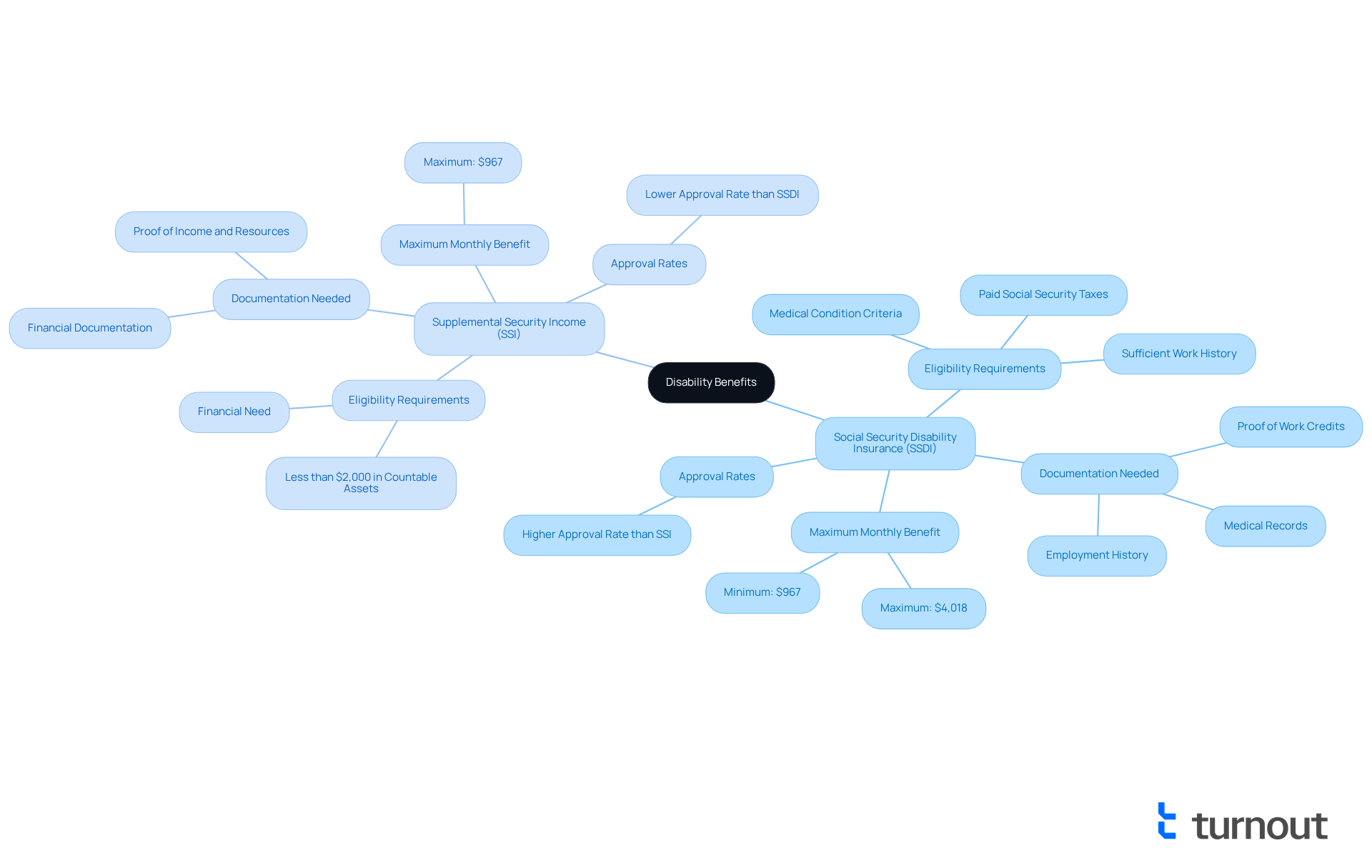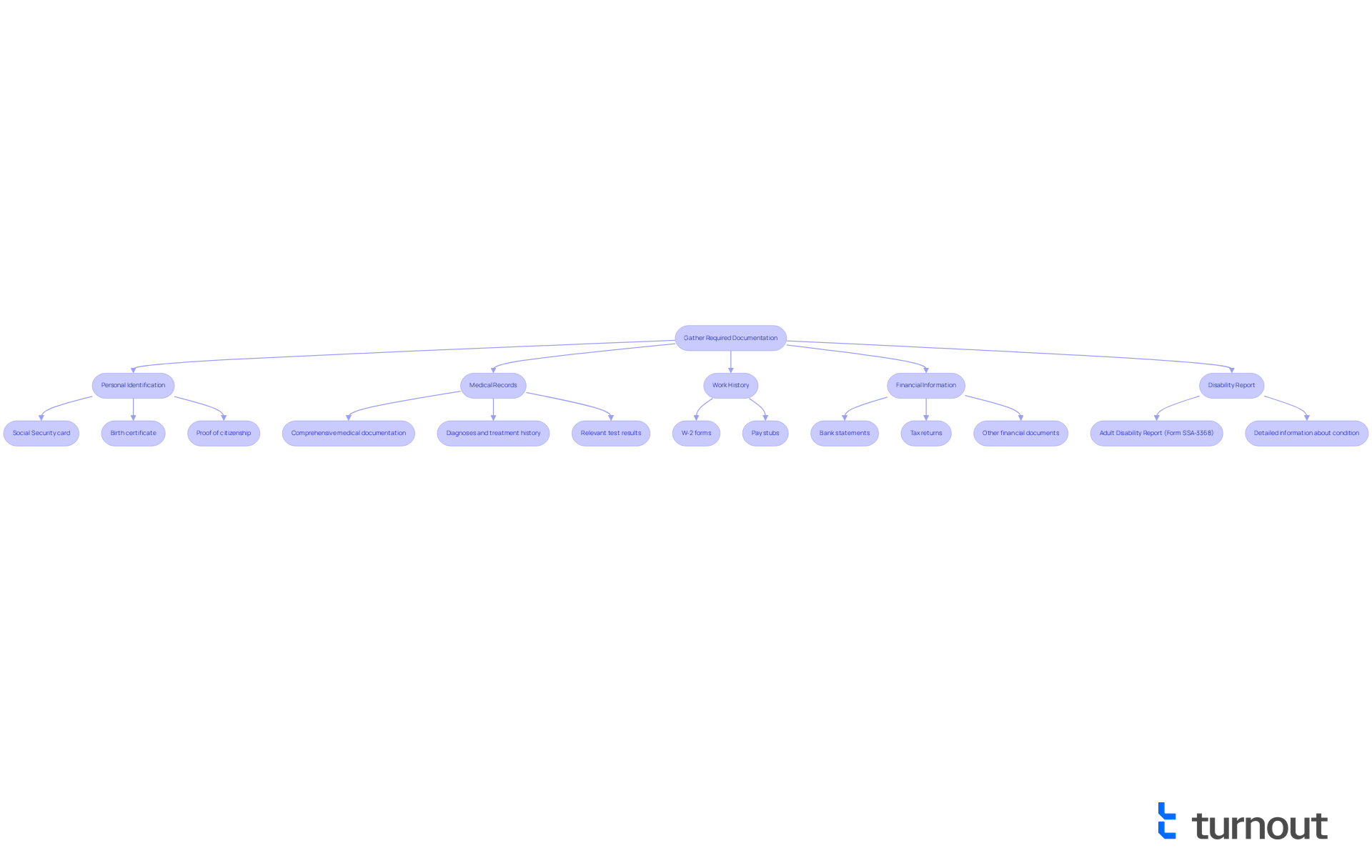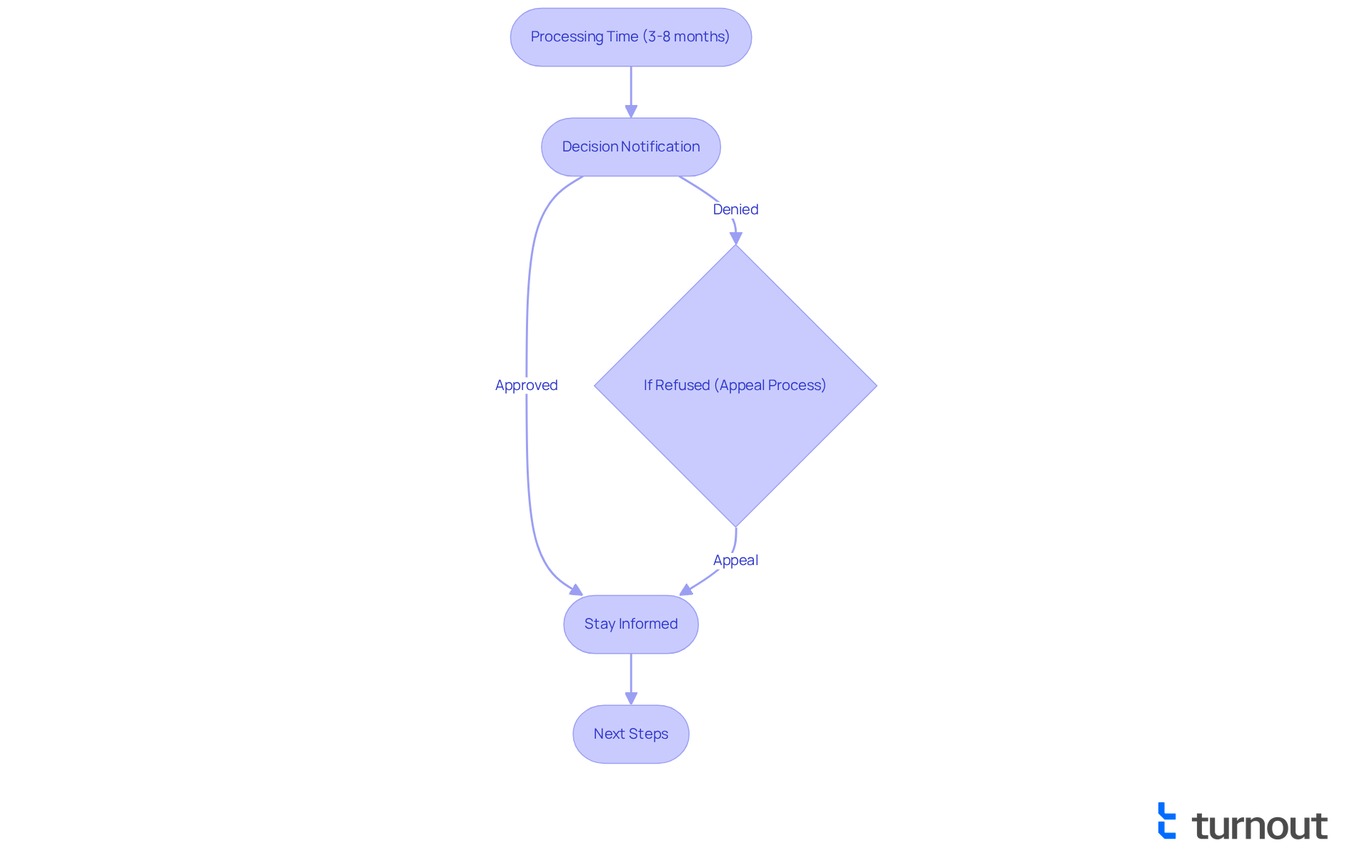Overview
Starting a disability application can feel overwhelming, but understanding the types of benefits available—SSDI and SSI—can make a significant difference. It’s important to gather the necessary documentation, including personal identification, medical records, and financial information. We understand that being well-prepared and knowledgeable about the eligibility criteria can greatly enhance your chances of approval.
Thorough documentation and a clear understanding of the application process are crucial for success. Remember, you are not alone in this journey. We’re here to help you navigate the process, ensuring you have the support you need every step of the way.
Introduction
Navigating the complex landscape of disability benefits can feel overwhelming. We understand that seeking support is crucial for your well-being. With two primary types of benefits—Social Security Disability Insurance (SSDI) and Supplemental Security Income (SSI)—each with distinct eligibility requirements, it’s essential to prepare yourself with the right information.
What happens when the application process feels daunting? How can you ensure you are fully equipped to tackle it? This guide will break down essential steps, from gathering necessary documentation to understanding what to expect after applying. You are not alone in this journey; we are here to empower you to approach your disability application with confidence and clarity.
Understand Disability Benefits: Eligibility and Types
Navigating the world of disability benefits can feel overwhelming, but understanding your options is the first step toward finding the support you need. Disability benefits primarily fall into two categories:
- Social Security Disability Insurance (SSDI)
- Supplemental Security Income (SSI)
To qualify for SSDI, you need a sufficient work history and must have paid Social Security taxes. On the other hand, SSI is based on financial need and does not require a work history, though it does take into account your income and resources.
It's essential to recognize these distinctions, as they shape the application process and the necessary documentation. For example, SSDI requires proof of work credits, while SSI needs financial documentation to demonstrate your need. As of 2025, the maximum monthly benefit for SSI is $967, and the monthly Substantial Gainful Activity (SGA) amount is $1,620 for non-blind individuals.
We encourage you to familiarize yourself with the specific eligibility criteria for each program. This knowledge is crucial in ensuring that you apply for the correct benefits. According to disability advocates, understanding these requirements can significantly enhance your chances of approval. In fact, SSDI typically has a higher approval rate than SSI.
Gathering the necessary documentation before applying for SSDI can also make the process smoother. Remember, you are not alone in this journey; we’re here to help you every step of the way.

Gather Required Documentation for Your Application
Before you learn how to start disability benefits, we understand that gathering the necessary documents can feel overwhelming. To make this process smoother, it's essential to collect the following important items:
- Personal Identification: This includes your Social Security card, birth certificate, or proof of citizenship to confirm your identity.
- Medical Records: It's crucial to gather comprehensive medical documentation from your healthcare providers. This should include your diagnoses, treatment history, and relevant test results that clearly illustrate how to start disability based on how your condition affects your ability to work. Remember, inadequate medical documentation is a common reason for rejections, so ensure that all records are current and thorough when learning how to start disability claims.
- Work History: Prepare a record of your employment, which should include W-2 forms or pay stubs. This will help demonstrate your work credits needed for SSDI eligibility.
- Financial Information: If you are applying for SSI, compile your bank statements, tax returns, and other financial documents that reflect your income and resources, ensuring they align with the SSA's eligibility criteria.
- Disability Report: Complete the Adult Disability Report (Form SSA-3368), providing detailed information about your condition and its effects on your daily life.
To understand how to start disability, consider organizing your documents in a dedicated folder for quick access to make the application process easier. Following up with the Social Security Administration (SSA) after submission is also important. This way, you can confirm that all necessary documents have been received and address any potential issues promptly.
And remember, you have the right to representation and support during this process. We're here to help, and having assistance can significantly enhance your chances of success. You are not alone in this journey.

Complete the Application Process: Step-by-Step Instructions
To successfully complete your disability benefits application, please follow these essential steps:
-
Choose Your Application Method: You can apply online via the Social Security Administration (SSA) website, by phone, or in person at your local SSA office. We understand that recent changes have made online submissions the quickest choice, allowing for electronic uploads of medical documents. However, it's important to be aware that the SSA currently has a backlog of approximately 575,000 requests, which may affect processing times.
-
Gather Necessary Information: Before beginning your submission, take a moment to collect all essential personal, medical, and work history details. This preparation is crucial for a smooth submission process, and we want to ensure you feel ready.
-
Create an Account: If you choose the online option, please establish a mySocialSecurity account to manage your request efficiently. This step will help you stay organized.
-
Complete the Form: Accurately fill in the form (Form SSA-16 for SSDI or the SSI request), ensuring all information aligns with your supporting documentation. The SSA emphasizes the importance of providing detailed information about your disabling condition, medical providers, treatments, employment history, and education. Remember, the more thorough you are, the better.
-
Submit Your Form: Before sending, thoroughly review your form for completeness and accuracy. Online forms enable you to save your progress and come back later if necessary, which can ease some of the pressure.
-
Receive Confirmation: After submission, expect a confirmation email or letter. Keep this for your records as evidence of your submission. It’s a small but important step in your journey.
Important Notes:
- Apply as soon as you become disabled to prevent delays in receiving benefits. We know that the typical processing duration for requests can fluctuate considerably, often requiring several months based on case complexity and the availability of medical evidence.
- Be prepared to provide additional information if requested by the SSA. Recent anti-fraud checks have delayed claim processing by 25%, so timely responses are essential. Remember, you are not alone in this process.
- For further assistance, consider utilizing the Adult Disability Starter Kit from the SSA, which offers a checklist to help arrange your submission details.
- If you are not computer savvy or live far from SSA offices, think about reaching out to local advocacy groups or support services for assistance. We’re here to help you every step of the way.

Navigate Post-Application: What to Expect and Next Steps
After submitting your application, here’s what you can expect:
-
Processing Time: We understand that waiting can be stressful. The Social Security Administration (SSA) typically requires 3 to 5 months to process requests. However, please be aware that the average wait time for an initial SSDI decision can extend up to 8 months. During this time, the SSA may ask for additional information or documentation, which could further prolong the timeline.
-
Decision Notification: You will receive a notice by mail regarding the outcome of your request. If approved, this notice will detail your benefits, including the amount and start date, helping you plan for your future.
-
If Refused: Should your request be denied, please know that you have the right to appeal. The notice will include instructions on how to file an appeal within 60 days. It's common to feel discouraged, but remember that the appeals procedure can take additional months, with hearing approval rates reaching 60-70%. This suggests a higher likelihood of success than initial submissions, so don't lose hope.
-
Stay Informed: We encourage you to utilize your mySocialSecurity account to check the status of your request and respond promptly to any inquiries from the SSA. Keeping track of all correspondence from the SSA is crucial for effectively managing your case.
Next Steps:
- Organize all correspondence from the SSA to ensure you have easy access to important information.
- If approved, prepare for your first payment and understand your ongoing responsibilities regarding income reporting or changes in your condition. Additionally, consider seeking legal help early in the process; this can significantly impact your application outcomes. Remember, you are not alone in this journey, and we’re here to help you every step of the way.

Conclusion
Navigating the disability application process can feel overwhelming, but understanding the essential steps can significantly ease your journey. This guide emphasizes the importance of knowing the different types of disability benefits available, such as Social Security Disability Insurance (SSDI) and Supplemental Security Income (SSI), along with the eligibility criteria that can help you determine which program is right for you. By familiarizing yourself with these aspects, you can better prepare for a successful submission.
Key points highlighted throughout this article include:
- The necessity of gathering comprehensive documentation
- A step-by-step approach to completing the application
- What to expect after submitting your application
From personal identification and medical records to understanding the processing timeline, each element plays a crucial role in enhancing your likelihood of approval. It’s vital to remain proactive and organized throughout this process; timely responses and thorough documentation can truly make a significant difference.
Ultimately, the journey to securing disability benefits is not one to undertake alone. By leveraging available resources, seeking assistance when needed, and maintaining a clear understanding of the process, you can navigate these complexities with greater confidence. Remember, the path to obtaining the support necessary for a better quality of life begins with informed action—make the first step today and empower yourself with the knowledge to succeed in your disability application.
Frequently Asked Questions
What are the two main types of disability benefits?
The two main types of disability benefits are Social Security Disability Insurance (SSDI) and Supplemental Security Income (SSI).
What are the eligibility requirements for SSDI?
To qualify for SSDI, you need a sufficient work history and must have paid Social Security taxes.
How does SSI differ from SSDI in terms of eligibility?
SSI is based on financial need and does not require a work history, although it does consider your income and resources.
What documentation is required for SSDI and SSI applications?
SSDI requires proof of work credits, while SSI needs financial documentation to demonstrate your need.
What is the maximum monthly benefit for SSI as of 2025?
The maximum monthly benefit for SSI is $967 as of 2025.
What is the monthly Substantial Gainful Activity (SGA) amount for non-blind individuals?
The monthly Substantial Gainful Activity (SGA) amount for non-blind individuals is $1,620.
Why is it important to understand the eligibility criteria for SSDI and SSI?
Understanding the eligibility criteria is crucial for applying for the correct benefits and can significantly enhance your chances of approval.
Which program typically has a higher approval rate, SSDI or SSI?
SSDI typically has a higher approval rate than SSI.
How can gathering necessary documentation help in the application process for SSDI?
Gathering the necessary documentation before applying for SSDI can make the application process smoother.




